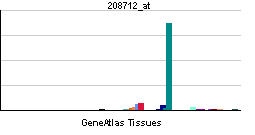Cyclin D1
| Cyclin D1 | |||||||||||
|---|---|---|---|---|---|---|---|---|---|---|---|
| Identifiers | |||||||||||
| Symbols | CCND1 ; BCL1; D11S287E; PRAD1; U21B31 | ||||||||||
| External IDs | Template:OMIM5 Template:MGI HomoloGene: 1334 | ||||||||||
| |||||||||||
| RNA expression pattern | |||||||||||
 | |||||||||||
 | |||||||||||
| More reference expression data | |||||||||||
| Orthologs | |||||||||||
| Template:GNF Ortholog box | |||||||||||
| Species | Human | Mouse | |||||||||
| Entrez | n/a | n/a | |||||||||
| Ensembl | n/a | n/a | |||||||||
| UniProt | n/a | n/a | |||||||||
| RefSeq (mRNA) | n/a | n/a | |||||||||
| RefSeq (protein) | n/a | n/a | |||||||||
| Location (UCSC) | n/a | n/a | |||||||||
| PubMed search | n/a | n/a | |||||||||
Cyclin D1, also known as CCND1, is a human gene.
The protein encoded by this gene belongs to the highly conserved cyclin family, whose members are characterized by a dramatic periodicity in protein abundance throughout the cell cycle. Cyclins function as regulators of CDK kinases. Different cyclins exhibit distinct expression and degradation patterns which contribute to the temporal coordination of each mitotic event. This cyclin forms a complex with and functions as a regulatory subunit of CDK4 or CDK6, whose activity is required for cell cycle G1/S transition. This protein has been shown to interact with tumor suppressor protein Rb and the expression of this gene is regulated positively by Rb. Mutations, amplification and overexpression of this gene, which alters cell cycle progression, are observed frequently in a variety of tumors and may contribute to tumorigenesis.[1]
References
Further reading
- Akita H (2003). "[Prognostic importance of altered expression of cell cycle regulators in lung cancer]". Nippon Rinsho. 60 Suppl 5: 267–71. PMID 12101670.
- Chung DC (2004). "Cyclin D1 in human neuroendocrine: tumorigenesis". Ann. N. Y. Acad. Sci. 1014: 209–17. PMID 15153436.
- Jain S, Khuri FR, Shin DM (2004). "Prevention of head and neck cancer: current status and future prospects". Current problems in cancer. 28 (5): 265–86. PMID 15375804.
- Gladden AB, Diehl JA (2006). "Location, location, location: the role of cyclin D1 nuclear localization in cancer". J. Cell. Biochem. 96 (5): 906–13. doi:10.1002/jcb.20613. PMID 16163738.
- Walker JL, Assoian RK (2006). "Integrin-dependent signal transduction regulating cyclin D1 expression and G1 phase cell cycle progression". Cancer Metastasis Rev. 24 (3): 383–93. doi:10.1007/s10555-005-5130-7. PMID 16258726.
- Gautschi O, Ratschiller D, Gugger M; et al. (2007). "Cyclin D1 in non-small cell lung cancer: a key driver of malignant transformation". Lung Cancer. 55 (1): 1–14. doi:10.1016/j.lungcan.2006.09.024. PMID 17070615.
- Li Z, Wang C, Prendergast GC, Pestell RG (2007). "Cyclin D1 functions in cell migration". Cell Cycle. 5 (21): 2440–2. PMID 17106256.
- Inaba T, Matsushime H, Valentine M; et al. (1992). "Genomic organization, chromosomal localization, and independent expression of human cyclin D genes". Genomics. 13 (3): 565–74. PMID 1386335.
- Schuuring E, Verhoeven E, Mooi WJ, Michalides RJ (1992). "Identification and cloning of two overexpressed genes, U21B31/PRAD1 and EMS1, within the amplified chromosome 11q13 region in human carcinomas". Oncogene. 7 (2): 355–61. PMID 1532244.
- Seto M, Yamamoto K, Iida S; et al. (1992). "Gene rearrangement and overexpression of PRAD1 in lymphoid malignancy with t(11;14)(q13;q32) translocation". Oncogene. 7 (7): 1401–6. PMID 1535701.
- Rosenberg CL, Wong E, Petty EM; et al. (1991). "PRAD1, a candidate BCL1 oncogene: mapping and expression in centrocytic lymphoma". Proc. Natl. Acad. Sci. U.S.A. 88 (21): 9638–42. PMID 1682919.
- Motokura T, Bloom T, Kim HG; et al. (1991). "A novel cyclin encoded by a bcl1-linked candidate oncogene". Nature. 350 (6318): 512–5. doi:10.1038/350512a0. PMID 1826542.
- Xiong Y, Connolly T, Futcher B, Beach D (1991). "Human D-type cyclin". Cell. 65 (4): 691–9. PMID 1827756.
- Lew DJ, Dulić V, Reed SI (1991). "Isolation of three novel human cyclins by rescue of G1 cyclin (Cln) function in yeast". Cell. 66 (6): 1197–206. PMID 1833066.
- Withers DA, Harvey RC, Faust JB; et al. (1991). "Characterization of a candidate bcl-1 gene". Mol. Cell. Biol. 11 (10): 4846–53. PMID 1833629.
- Tsujimoto Y, Yunis J, Onorato-Showe L; et al. (1984). "Molecular cloning of the chromosomal breakpoint of B-cell lymphomas and leukemias with the t(11;14) chromosome translocation". Science. 224 (4656): 1403–6. PMID 6610211.
- Hall M, Bates S, Peters G (1995). "Evidence for different modes of action of cyclin-dependent kinase inhibitors: p15 and p16 bind to kinases, p21 and p27 bind to cyclins". Oncogene. 11 (8): 1581–8. PMID 7478582.
- Tassan JP, Jaquenoud M, Léopold P; et al. (1995). "Identification of human cyclin-dependent kinase 8, a putative protein kinase partner for cyclin C.". Proc. Natl. Acad. Sci. U.S.A. 92 (19): 8871–5. PMID 7568034.
- Fornaro M, Dell'Arciprete R, Stella M; et al. (1995). "Cloning of the gene encoding Trop-2, a cell-surface glycoprotein expressed by human carcinomas". Int. J. Cancer. 62 (5): 610–8. PMID 7665234.
- Motokura T, Arnold A (1993). "PRAD1/cyclin D1 proto-oncogene: genomic organization, 5' DNA sequence, and sequence of a tumor-specific rearrangement breakpoint". Genes Chromosomes Cancer. 7 (2): 89–95. PMID 7687458.
| This protein-related article is a stub. You can help Wikipedia by expanding it. |